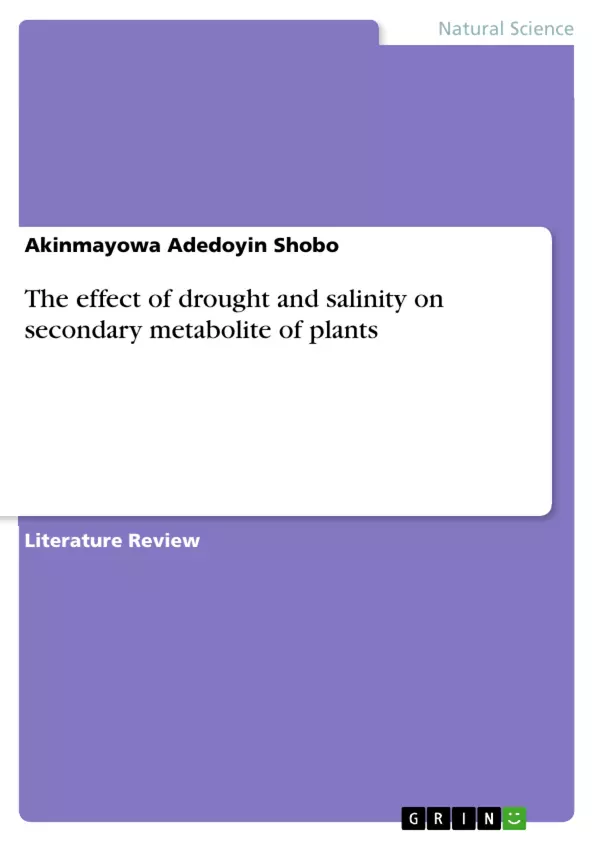Since recent history, there have been tremendous efforts in combating the challenges of food insecurity. This mini-review discusses how environmental conditions favour or impair the growth and survival of plants via the molecular mechanisms of the secondary metabolites. Like animals, plants have survived many eons by evolving adaptive mechanisms in the presence of the myriad of abiotic and biotic stressors. In this text, the subject of drought and salt content in relationship to their role in biosynthesis of secondary metabolites is being discussed.
Fundamentally, plants require optimum concentrations of microfauna/ micronutrients and favourable climatic/edaphic conditions in their metabolism. Consequently, they produce primary metabolites (such as carbohydrates, amino acids among others) that are needed for the normal growth and reproduction of plants.
On the other hand, the secondary metabolites are mostly needed for ecological functions and regulating the primary metabolic pathways. Plants via their diverse pathways (TCA cycle, MEP pathway, shikimic pathway, mevalonate pathways) have been found to produce secondary metabolites such as terpenes, phenolic and nitrogen-based compounds. These secondary metabolites have been linked to affect crop yield and medicinal properties of plants in addition to other applications. Through well-controlled machinery of signal transduction; in response to ionic and osmotic balances, the biosynthesis of secondary metabolites has been known to be induced or inhibited for the growth and survival of the plant species.
Inhaltsverzeichnis (Table of Contents)
- DEDICATION
- ACKNOWLEDGEMENT
- INTRODUCTION
- CHAPTER ONE
- 1.1 Introduction
- 1.2 Definition of salinity
- 1.3 How to measure salinity
- 1.4 Definition of Drought
- 1.4.1 Causes of drought
- 1.4.2 Types of drought
- 1.4.3 Consequences of drought
- CHAPTER TWO
- 2.1 Definition of metabolite
- 2.1.1 Examples of metabolite
- 2.1.2 Types of metabolite
- 2.2 Primary metabolite
- 2.3 Secondary metabolite
- 2.1 Definition of metabolite
- CHAPTER THREE
- 3.1 Plant Physiology and Metabolism
- 3.2 Role of Secondary metabolites
- CHAPTER FOUR
- 4.1 Antioxidant system and Plant metabolism
- 4.2 Environmental stressors
- 4.3 Free radicals / Reactive Oxygen Species (ROS)
- 4.4 Effect of Drought on Plant Physiology and Metabolism
- 4.5 Effect of Salinity on Plant Physiology and Metabolism
- 4.6 Relationship between drought and Salinity
- 4.7 Effect of drought and salinity on Secondary Metabolites
Zielsetzung und Themenschwerpunkte (Objectives and Key Themes)
This work aims to explore the effects of salinity and drought on secondary metabolites in plants. It delves into the definitions and causes of both salinity and drought, discussing their impact on plant physiology and metabolism.
- Definition and measurement of salinity
- Causes, types, and consequences of drought
- The role of secondary metabolites in plant physiology
- The impact of environmental stressors on plant metabolism
- The relationship between drought and salinity and their combined effects on secondary metabolites
Zusammenfassung der Kapitel (Chapter Summaries)
- Chapter One introduces the concepts of salinity and drought, defining their characteristics and outlining their causes, types, and consequences.
- Chapter Two defines metabolites and categorizes them into primary and secondary metabolites, providing examples of each.
- Chapter Three explores the role of secondary metabolites in plant physiology and metabolism.
- Chapter Four delves into the antioxidant system and plant metabolism, examining the effects of environmental stressors, including drought and salinity, on plant physiology and metabolism. It also discusses the relationship between drought and salinity and their combined effects on secondary metabolites.
Schlüsselwörter (Keywords)
The primary focus of this work revolves around the effects of salinity and drought on secondary metabolites in plants. Key terms include: salinity, drought, metabolites, primary metabolites, secondary metabolites, plant physiology, plant metabolism, environmental stressors, free radicals, reactive oxygen species (ROS), and antioxidant system.
- Quote paper
- Akinmayowa Adedoyin Shobo (Author), 2018, The effect of drought and salinity on secondary metabolite of plants, Munich, GRIN Verlag, https://www.hausarbeiten.de/document/494142


